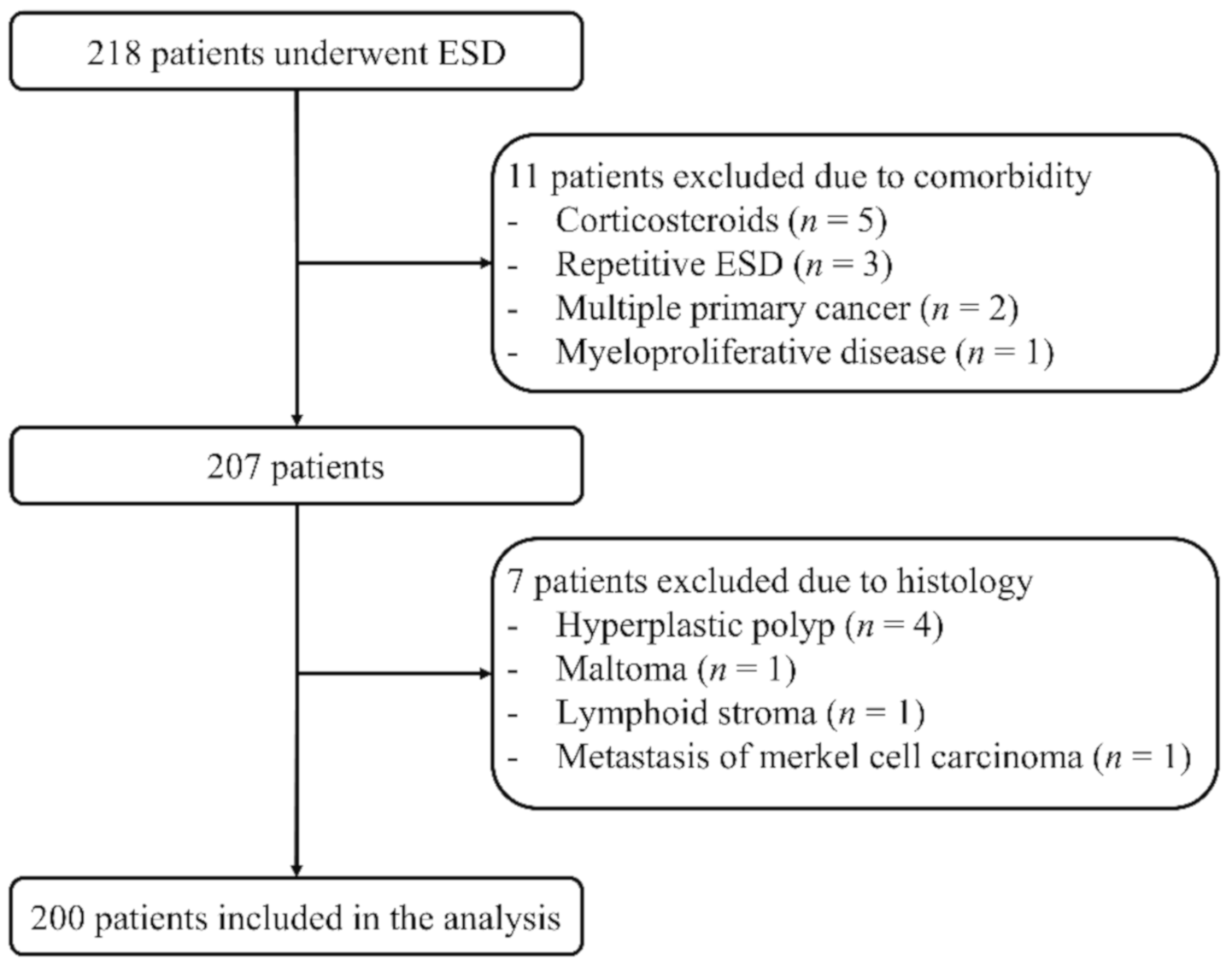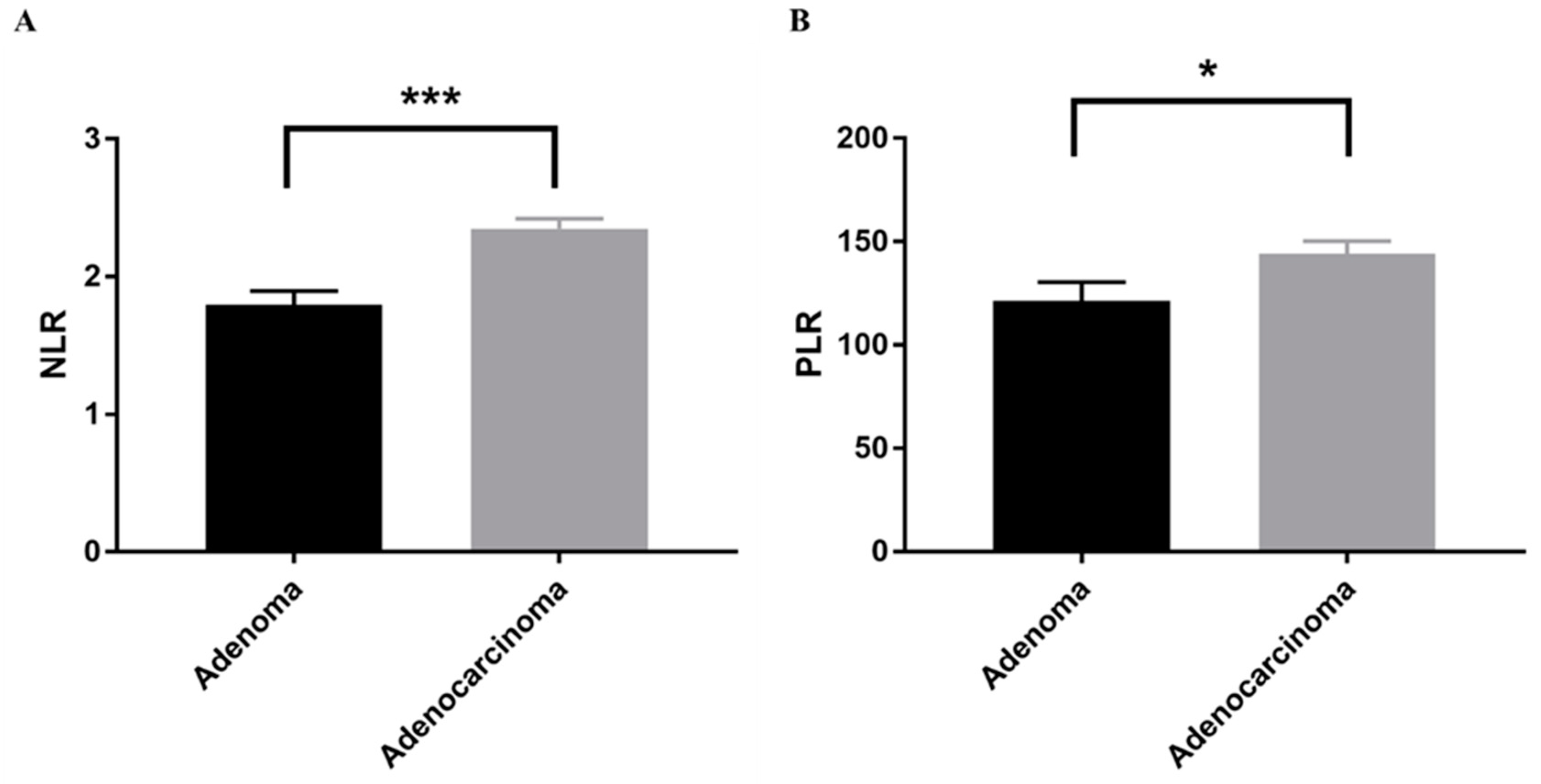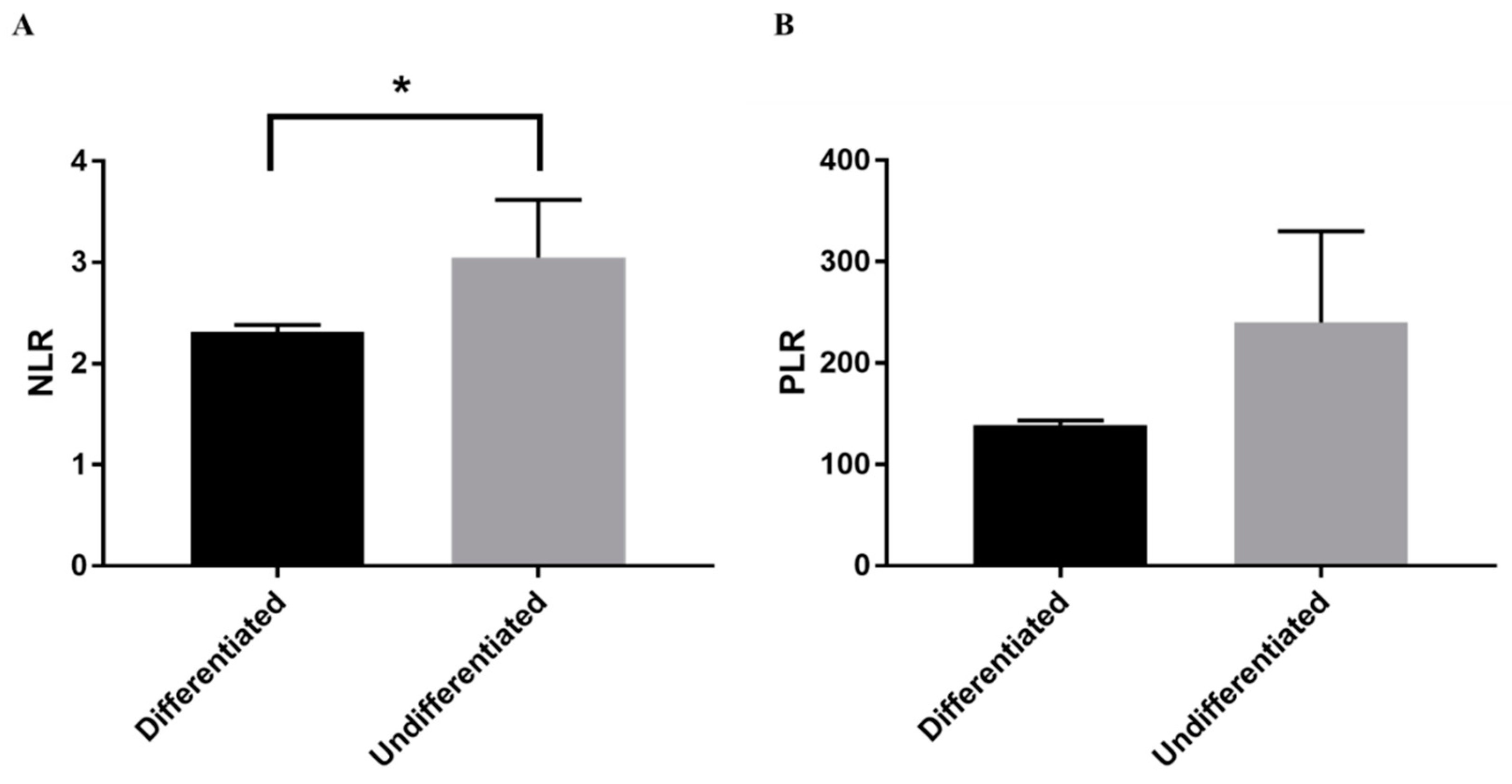Neutrophil-to-Lymphocyte Ratio Is a Useful Marker for Predicting Histological Types of Early Gastric Cancer
Abstract
:1. Introduction
2. Materials and Methods
2.1. Study Population
2.2. Clinical and Laboratory Findings
2.3. Statistical Analysis
3. Results
3.1. Patient Characteristics
3.2. Differences in NLR and PLR between Benign and Malignant Tumors
3.3. Differences in NLR and PLR between Histological Types
4. Discussion
5. Conclusions
Author Contributions
Funding
Institutional Review Board Statement
Informed Consent Statement
Data Availability Statement
Conflicts of Interest
References
- Fitzmaurice, C.; Dicker, D.; Pain, A.W.; Hamavid, H.; Moradi-Lakeh, M.; MacIntyre, M.F.; Allen, C.; Hansen, G.M.; Woodbrook, R.; Wolfe, C.; et al. The Global Burden of Cancer 2013. JAMA Oncol. 2015, 1, 505–527. [Google Scholar] [CrossRef]
- Toyokawa, T.; Inaba, T.; Omote, S.; Okamoto, A.; Miyasaka, R.; Watanabe, K.; Izumikawa, K.; Fujita, I.; Horii, J.; Ishikawa, S.; et al. Risk factors for non-curative resection of early gastric neoplasms with endoscopic submucosal dissection: Analysis of 1,123 lesions. Exp. Ther. Med. 2015, 9, 1209–1214. [Google Scholar] [CrossRef] [Green Version]
- Horiuchi, Y.; Fujisaki, J.; Yamamoto, N.; Ishizuka, N.; Omae, M.; Ishiyama, A.; Yoshio, T.; Hirasawa, T.; Yamamoto, Y.; Nagahama, M.; et al. Undifferentiated-type component mixed with differentiated-type early gastric cancer is a significant risk factor for endoscopic non-curative resection. Dig. Endosc. 2018, 30, 624–632. [Google Scholar] [CrossRef]
- Mae, Y.; Takata, T.; Ida, A.; Ogawa, M.; Taniguchi, S.; Yamamoto, M.; Iyama, T.; Fukuda, S.; Isomoto, H. Prognostic Value of Neutrophil-To-Lymphocyte Ratio and Platelet-To-Lymphocyte Ratio for Renal Outcomes in Patients with Rapidly Progressive Glomerulonephritis. J. Clin. Med. 2020, 9, 1128. [Google Scholar] [CrossRef] [Green Version]
- Orditura, M.; Galizia, G.; Diana, A.; Saccone, C.; Cobellis, L.; Ventriglia, J.; Iovino, F.; Romano, C.; Morgillo, F.; Mosca, L.; et al. Neutrophil to lymphocyte ratio (NLR) for prediction of distant metastasis-free survival (DMFS) in early breast cancer: A propensity score-matched analysis. ESMO Open 2016, 1, e000038. [Google Scholar] [CrossRef] [PubMed] [Green Version]
- Miyazaki, T.; Sakai, M.; Sohda, M.; Tanaka, N.; Yokobori, T.; Motegi, Y.; Nakajima, M.; Fukuchi, M.; Kato, H.; Kuwano, H. Prognostic Significance of Inflammatory and Nutritional Parameters in Patients with Esophageal Cancer. Anticancer Res. 2016, 36, 6557–6562. [Google Scholar] [CrossRef] [PubMed]
- Moon, H.; Roh, J.-L.; Lee, S.-W.; Kim, S.-B.; Choi, S.-H.; Nam, S.Y.; Kim, S.Y. Prognostic value of nutritional and hematologic markers in head and neck squamous cell carcinoma treated by chemoradiotherapy. Radiother. Oncol. 2016, 118, 330–334. [Google Scholar] [CrossRef]
- Zhang, H.; Zhang, L.; Zhu, K.; Shi, B.; Yin, Y.; Zhu, J.; Yue, D.; Zhang, B.; Wang, C. Prognostic Significance of Combination of Preoperative Platelet Count and Neutrophil-Lymphocyte Ratio (COP-NLR) in Patients with Non-Small Cell Lung Cancer: Based on a Large Cohort Study. PLoS ONE 2015, 10, e0126496. [Google Scholar] [CrossRef] [Green Version]
- Diakos, C.I.; Charles, K.A.; McMillan, D.C.; Clarke, S.J. Cancer-related inflammation and treatment effectiveness. Lancet Oncol. 2014, 15, e493–e503. [Google Scholar] [CrossRef]
- Roxburgh, C.S.D.; McMillan, D.C. Cancer and systemic inflammation: Treat the tumour and treat the host. Br. J. Cancer 2014, 110, 1409–1412. [Google Scholar] [CrossRef]
- Arigami, T.; Uenosono, Y.; Matsushita, D.; Yanagita, S.; Uchikado, Y.; Kita, Y.; Mori, S.; Kijima, Y.; Okumura, H.; Maemura, K.; et al. Combined fibrinogen concentration and neutrophil-lymphocyte ratio as a prognostic marker of gastric cancer. Oncol. Lett. 2016, 11, 1537–1544. [Google Scholar] [CrossRef] [PubMed] [Green Version]
- Japanese Gastric Cancer Association. Japanese Gastric cancer treatment guidelines 2018 (5th edition). Gastric Cancer 2021, 1, 1–21. [Google Scholar]
- Küçük, H.; Göker, B.; Varan, Ö.; Dumludag, B.; Haznedaroğlu, Ş.; Öztürk, M.A.; Tufan, A.; Emiroglu, T.; Erten, Y. Pre-dictive value of neutrophil/lymphocyte ratio in renal prognosis of patients with granulomatosis with polyangiitis. Ren. Fail. 2017, 39, 273–276. [Google Scholar] [CrossRef] [Green Version]
- Park, H.J.; Jung, S.M.; Song, J.J.; Park, Y.-B.; Lee, S.-W. Platelet to lymphocyte ratio is associated with the current activity of ANCA-associated vasculitis at diagnosis: A retrospective monocentric study. Rheumatol. Int. 2018, 38, 1865–1871. [Google Scholar] [CrossRef] [PubMed]
- Schulze-Koops, H. Lymphopenia and autoimmune diseases. Arthritis Res. Ther. 2004, 6, 178–180. [Google Scholar] [CrossRef] [PubMed] [Green Version]
- Alifano, M.; Mansuet-Lupo, A.; Lococo, F.; Roche, N.; Bobbio, A.; Canny, E.; Schussler, O.; Dermine, H.; Régnard, J.-F.; Burroni, B.; et al. Systemic Inflammation, Nutritional Status and Tumor Immune Microenvironment Determine Outcome of Resected Non-Small Cell Lung Cancer. PLoS ONE 2014, 9, e106914. [Google Scholar] [CrossRef] [Green Version]
- Semenza, G.L.; Ruvolo, P.P. Introduction to tumor microenvironment regulation of cancer cell survival, metastasis, inflammation, and immune surveillance. Biochim. Biophys. Acta BBA Bioenergy 2016, 1863, 379–381. [Google Scholar] [CrossRef]
- Dunn, G.P.; Old, L.J.; Schreiber, R.D. The Immunobiology of Cancer Immunosurveillance and Immunoediting. Immunity 2004, 21, 137–148. [Google Scholar] [CrossRef] [Green Version]
- Yamashita, H.; Katai, H. Systemic Inflammatory Response in Gastric Cancer. World J. Surg. 2010, 34, 2399–2400. [Google Scholar] [CrossRef]
- Chen, L.; Yan, Y.; Zhu, L.; Cong, X.; Li, S.; Song, S.; Song, H.; Xue, Y. Systemic immune–inflammation index as a useful prognostic indicator predicts survival in patients with advanced gastric cancer treated with neoadjuvant chemotherapy. Cancer Manag. Res. 2017, 9, 849–867. [Google Scholar] [CrossRef] [Green Version]
- Jiang, N.; Deng, J.Y.; Liu, Y.; Ke, B.; Liu, H.G.; Liang, H. The role of preoperative neutrophil-lymphocyte and plate-let-lymphocyte ratio in patients after radical resection for gastric cancer. Biomarkers 2014, 19, 444–451. [Google Scholar] [CrossRef]
- Lee, S.; Oh, S.Y.; Kim, S.H.; Lee, J.H.; Kim, M.C.; Kim, K.H.; Kim, H.-J. Prognostic significance of neutrophil lymphocyte ratio and platelet lymphocyte ratio in advanced gastric cancer patients treated with FOLFOX chemotherapy. BMC Cancer 2013, 13, 350. [Google Scholar] [CrossRef] [Green Version]
- Deng, Q.-W.; He, B.; Liu, X.; Yue, J.; Ying, H.; Pan, Y.; Sun, H.; Chen, J.; Wang, F.; Gao, T.; et al. Prognostic value of pre-operative inflammatory response biomarkers in gastric cancer patients and the construction of a predictive model. J. Transl. Med. 2015, 13, 66. [Google Scholar] [CrossRef] [PubMed] [Green Version]
- Fang, T.; Wang, Y.; Yin, X.; Zhai, Z.; Zhang, Y.; Yang, Y.; You, Q.; Li, Z.; Ma, Y.; Li, C.; et al. Diagnostic Sensitivity of NLR and PLR in Early Diagnosis of Gastric Cancer. J. Immunol. Res. 2020, 2020, 1–9. [Google Scholar] [CrossRef]
- Aihara, R.; Mochiki, E.; Kamiyama, Y.; Kamimura, H.; Asao, T.; Kuwano, H. Mucin phenotypic expression in early signet ring cell carcinoma of the stomach: Its relationship with the clinicopathologic factors. Dig. Dis. Sci. 2004, 49, 417–424. [Google Scholar] [CrossRef] [PubMed]
- Farah, R.; Khamisy-Farah, R. Association of neutrophil to lymphocyte ratio with presence and severity of gastritis due to Helicobacter pylori infection. J. Clin. Lab. Anal. 2014, 28, 219–223. [Google Scholar] [CrossRef] [PubMed]
- Boyuk, B.; Saydan, D.; Mavis, O.; Erman, H. Evaluation of Helicobacter pylori Infection, Neutrophil–Lymphocyte Ratio and Platelet–Lymphocyte Ratio in Dyspeptic Patients. Gastroenterol. Insights 2020, 11, 2. [Google Scholar] [CrossRef]



| Parameter | Total | Adenoma | Adenocarcinoma | p-Value |
|---|---|---|---|---|
| Number | 200 | 36 | 164 | |
| Age, years | 73.5 ± 8.8 | 72.2 ± 8.2 | 73.8 ± 8.9 | ns |
| Sex, male/female | 156/44 | 28/8 | 128/36 | ns |
| Lesion size, cm2 | 2.3 (0.1–42.0) | 2.4 (0.2–13.3) | 2.3 (0.1–42.0) | ns |
| White blood cell count, /×103μL | 5.7 ± 1.5 | 5.9 ± 1.4 | 5.6 ± 1.5 | ns |
| Neutrophil count, /×103μL | 3.5 ± 1.1 | 3.4 ± 1.0 | 3.5 ± 1.1 | ns |
| Lymphocyte count, /× 103μL | 1.7 ± 0.6 | 2.0 ± 0.6 | 1.6 ± 0.5 | <0.001 a |
| Platelet count, /×103μL | 210 ± 61 | 224 ± 70 | 207 ± 59 | ns |
| CRP, mg/dL | 0.1 (0–3.6) | 0.1 (0–2.4) | 0.1 (0–3.6) | ns |
| NLR | 2.2 ± 0.9 | 1.8 ± 0.6 | 2.3 ± 0.9 | <0.001 a |
| PLR | 125 (40–844) | 115 (50–353) | 128 (40–403) | <0.05 b |
| Parameter | Differentiated | Undifferentiated | p-Value |
|---|---|---|---|
| Number | 156 | 8 | |
| Age, years | 74.1 ± 8.5 | 67.1 ± 13.6 | <0.05 a |
| Sex, male/female | 122/34 | 6/2 | ns |
| Lesion size, cm2 | 2.3 (0.1–42.0) | 1.7 (1.0–5.4) | ns |
| White blood cell count, /×103μL | 5.6 ± 1.5 | 5.2 ± 2.2 | ns |
| Neutrophil count, /×103μL | 3.5 ± 1.1 | 3.4 ± 1.7 | ns |
| Lymphocyte count, /×103μL | 1.6 ± 0.5 | 1.3 ± 6.3 | ns |
| Platelet count, /×103μL | 206 ± 57 | 220 ± 94 | ns |
| CRP, mg/dL | 0.1 (0–3.6) | 0.2 (0–1.4) | ns |
| NLR | 2.3 ± 0.9 | 3.1 ± 1.6 | <0.05 a |
| PLR | 128 (40–403) | 149 (63–844) | ns |
Publisher’s Note: MDPI stays neutral with regard to jurisdictional claims in published maps and institutional affiliations. |
© 2021 by the authors. Licensee MDPI, Basel, Switzerland. This article is an open access article distributed under the terms and conditions of the Creative Commons Attribution (CC BY) license (http://creativecommons.org/licenses/by/4.0/).
Share and Cite
Yasui, S.; Takata, T.; Kamitani, Y.; Mae, Y.; Kurumi, H.; Ikebuchi, Y.; Yoshida, A.; Kawaguchi, K.; Yashima, K.; Isomoto, H. Neutrophil-to-Lymphocyte Ratio Is a Useful Marker for Predicting Histological Types of Early Gastric Cancer. J. Clin. Med. 2021, 10, 791. https://doi.org/10.3390/jcm10040791
Yasui S, Takata T, Kamitani Y, Mae Y, Kurumi H, Ikebuchi Y, Yoshida A, Kawaguchi K, Yashima K, Isomoto H. Neutrophil-to-Lymphocyte Ratio Is a Useful Marker for Predicting Histological Types of Early Gastric Cancer. Journal of Clinical Medicine. 2021; 10(4):791. https://doi.org/10.3390/jcm10040791
Chicago/Turabian StyleYasui, Sho, Tomoaki Takata, Yu Kamitani, Yukari Mae, Hiroki Kurumi, Yuichiro Ikebuchi, Akira Yoshida, Koichiro Kawaguchi, Kazuo Yashima, and Hajime Isomoto. 2021. "Neutrophil-to-Lymphocyte Ratio Is a Useful Marker for Predicting Histological Types of Early Gastric Cancer" Journal of Clinical Medicine 10, no. 4: 791. https://doi.org/10.3390/jcm10040791
APA StyleYasui, S., Takata, T., Kamitani, Y., Mae, Y., Kurumi, H., Ikebuchi, Y., Yoshida, A., Kawaguchi, K., Yashima, K., & Isomoto, H. (2021). Neutrophil-to-Lymphocyte Ratio Is a Useful Marker for Predicting Histological Types of Early Gastric Cancer. Journal of Clinical Medicine, 10(4), 791. https://doi.org/10.3390/jcm10040791








